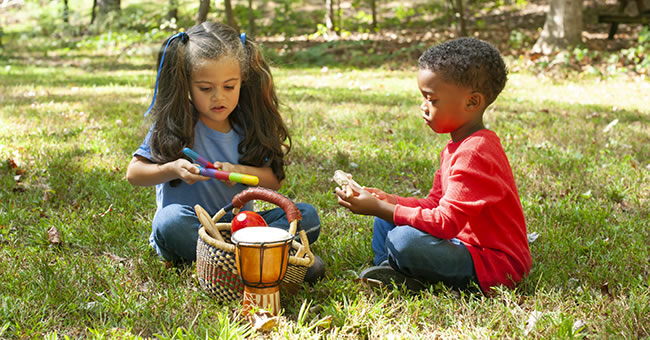
Creating music enables children to use a multi-sensory approach to learning. When children make music they are listening, seeing, moving and feeling. The use of rhythm instruments and music as learning tools enhances the development of auditory skills, fine motor skills, sense of rhythm, body awareness, and coordination of mind and body. Rhythm sticks are also easy to hold and manipulate which is perfect for young children.
Here are eleven ideas for using rhythm sticks in your classroom:
How to Incorporate Rhythm Sticks in Your Classroom
1. Have everyone sit in a circle on the floor. Pass one pair of rhythm sticks around and ask each child to tap the sticks together in rhythm with his or her first name. This activity makes a great icebreaker!
2. Ask everyone to sit in a circle on the floor. Give each child a pair of rhythm sticks. Play a rhythm pattern on the sticks and ask them to echo the pattern with their own sticks. Let each child have a turn at being the leader.
3. Play a pattern and keep it going. Ask each child in turn to make up their own patterns and play along with you. Go around the circle until all children are playing their sticks.
4. Set several different items on a table, e.g. a book, ruler, plastic tub. Let everyone take turns tapping the sticks on each item. How do they sound different? Do any sound similar?
5. Bring several metal pans or pots of varying sizes. Let the children tap each one. Notice that the larger ones produce a lower sound, the smaller ones a higher sound.
6. Try imitating other sounds with the sticks. Tapping the rhythm sticks on a desk may sound like rain, and tapping on a window may sound like a woodpecker. Try other surfaces, like a shoe or the floor. What do these sounds sound like?
7. Pair each child with a partner. Have one child tap out a pattern on the sticks and the other child echo it. Switch "leaders" and "echoes."
8. Teach the class a simple song, like Bingo. Tap the sticks on B–I–N&ndashG–O; substitute the sticks for the actual letters.'
9. Tap the stick loudly three times on the floor, saying "LOUD, LOUD, LOUD." Then tap softly and say "soft, soft, soft."
10. Teach the class about different meters (number of beats) in music. Have them count each beat as they tap and repeat the following pattern several times. Try playing waltz music, for example, and have the children count out the rhythm as they listen.
11. Have the class say the following while they tap: "TAP, TAP, TAP, WAIT." Tap only on the word "TAP." Rest on the word "WAIT". Change the pattern: "TAP, WAIT, TAP, WAIT." After they have learned the patterns, leave out the words and use only the sticks.
